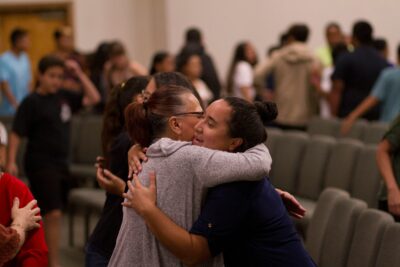
What’s Attracting Spiritually-Curious Millennials? Research Says Old and Traditional
Church leaders can spend millions on a glorified concert hall, but what spiritually-curious Millennials really want is a church that looks like a church.
A lot has been written about the national decline in church memberships and regular church attendance. For years, church leaders have read about the decades-old downturns which prophesy that mainline Protestantism has (maybe) a mere 23 Easters left in its future.
Practically every church leader is aware of these statistics. In fact, the Church Growth Movement emerged as a response to these declines. Since then, churches everywhere have applied innovative growth and marketing practices borrowed from corporations in the hope that they would reverse the tide. Or stem it.
But recently, more attention has been given to the youth and the rise of the so-called “Nones”: (mostly) twenty-somethings who identify as spiritual but non-religious. According to the Pew Research Center, “one-fifth of the US public—and a third of adults under 30—are religiously unaffiliated today.” These are the highest percentages in the history of the poll, and the highest rates of decline have occurred in just the last five years. Though general polls are enough to make any church leader chew his nails, the rates are bleakest among the youth.
Why this is the case is anyone’s guess—but that’s no reason not to publish it. With every new analytical report, blog post, or anecdote, a new cause is diagnosed, and the issue becomes more complex and multifaceted. Meanwhile, thoughtful, self-limiting analysis is hard to come by. Proposed solutions are just as varied and, thus far, seem to have done little to plug the leaks.
Church leaders everywhere fear their churches are one generation away from drying up.
Consequently, many church leaders have trained themselves to scroll past any headline with the word “Millennial.” We can only take so much bad news.
The Shock of Good News
So when a recent study, commissioned by Hope Revolution Partnership and carried out by ComRes, reported that one in six young people are practicing Christians, the team didn’t publish the results for another six months, convinced they must have made some error. Jimmy Dale, the Church of England’s national youth evangelism officer, told The Telegraph, “There was disbelief among the team because it was so high.”
It seemed too good to be true.
After undergoing review, the study was published in June with its surprising conclusion: The number of young Christians is higher than previously thought.
2,000 people aged 11-18 were interviewed for the poll. 21 percent claimed to be active followers of Jesus and 13 percent claimed to attend church regularly, suggesting the number of teenagers who identify as Christian had nearly doubled within the last decade. Although these studies were conducted in the United Kingdom, church leaders in the US should take note.
What’s Bringing Millennials to Church?
When it comes to engaging Millennials, everyone has an opinion, and not all are bad. However, very few take a look at what Millennials are actually doing. Most people would tell you the key to engaging Millennials has something to do with small groups growth strategy, a church mobile app, an inbound strategy, an invitational culture, or a “missional community.” However, this study suggests that innovative outreach practices invested in by the church turned out to be less effective in converting the youth than visiting a church building.
But not just any church building.
Around 13 percent of those interviewed claimed that visiting a traditional church building, such as a cathedral, was more influential in their conversion than youth groups or being evangelized by other Christians.
“Things which we would class as old-hat methods are some of the more effective ways,” says Dale. “It’s a real wake-up call for the church—we’ve got lots of young people who are coming into churches with school groups, and that’s a really integral part of them becoming Christians.”
What’s So Special about Traditional Churches?
It may surprise the reader, but in a word: They look Christian.
As we’ve said before on this blog, Millennials crave authenticity. Every day, Millennials are asking themselves and their neighbors, “What is Christianity, anyway?” Gracy Olmstead reports in The American Conservative that some young people leaving mainline Protestantism, rather than abandoning Christianity, “are joining more traditional, liturgical denominations—notably the Roman Catholic, Anglican, and Orthodox branches of the faith. This trend is deeper than denominational waffling: It’s a search for meaning that goes to the heart of our postmodern age.”
Though this does not account for all young people leaving the church, it’s a definite trend. Millennials are hunting for a Christianity that presents itself as the historic faith that it is. When the Church is interchangeable with other institutions or nonprofits, such as a club or a soup kitchen, then its existence becomes less necessary. They want a definite Christianity.
Christianity has an identity forged over several centuries. It has two millennia of tradition at its disposal. And yet, perhaps more than any religion in the world, Protestant Christianity—particularly its American variety—is the most hesitant to avail itself of the historic contents of its own religion, despite what it has to offer to the modern world.
At any rate, church leaders can spend millions on a glorified concert hall, but according to recent research, what Millennials really want is a church that looks like a church.
Beautiful Churches Aren’t Always Feasible
While cathedrals can be opulent, John Inge, Bishop of Worcester, believes “it’s just as likely to be one of the parish churches which [these young people] have been inspired by.” These traditional parish churches are modest in comparison to their dazzling urban sisters, but they still boast excellent stonework, stained-glass windows, arched roofs, and steepled towers. You don’t need to compete with St. Peter’s Basilica to have a simple but beautiful and liturgically-minded building.
Even so, it’s not always an option.
My own church recently held a meeting to discuss the purchase of a new building. We were blessed with a growing membership, but our little sanctuary was bursting at the seams. Though it had served us well, I looked forward to the possibility of a more traditional building. Instead, my pastor regretfully informed me that such prospects are dim: There were few traditional churches in the area, and many were so old that renovations would sap our finances dry after a few months. We would most likely settle on an even more modern-style building than we currently have.
Traditional churches aren’t always a possibility, which is why they aren’t a requirement. God is pleased whether we worship Him in a cathedral or a catacomb. He cannot be confined in a temple like an idol. Beautiful churches are not for God, but for the Body of Christ on earth. If the Body of Christ is the Church, then the building is the clothing, and we should “dress” as though we were meeting God at a wedding feast (Mat. 22).
King David’s desire to build God’s temple was a gift of the Holy Spirit (2 Sam. 7). It’s obvious the desire for a beautiful sanctuary to worship God was appropriate, good, and even inspired. But for David, it would remain only a desire. God essentially said “No, your offspring will build a house for my name.” So, instead, David made the necessary preparations for the construction of the temple by his successor, Solomon.
Similarly, it is a good thing for us to desire to worship our God in a beautiful house (even if we can’t). Secondly, we can always put something forward so that future generations will. A total giving and engagement solution makes this feasible. With a custom church app experience like Pushpay, special funds are easy to set up and use. Consider scheduling a demo today, and put something aside for future worshippers. If you are fortunate enough to worship in a traditional building already, you can set up special funds just for upkeep. If you bring specific building-related needs to your flock’s attention, you might be surprised by how freely they will give.





